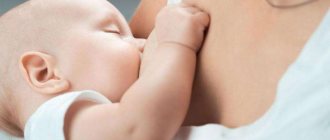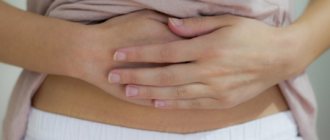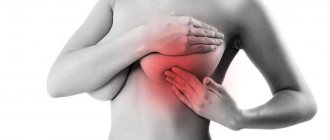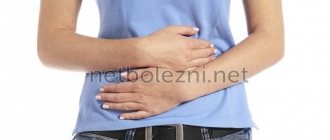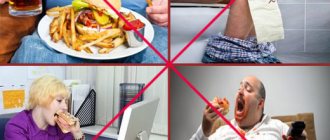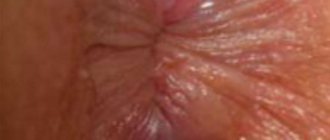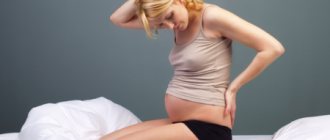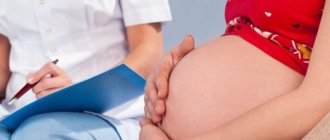During childbirth, the female body experiences enormous physical stress, all organs and systems work in extreme mode. If contractions are tolerated passively, then pushing requires the woman to actively participate in the process. When pushing, the muscles of the diaphragm and chest press intensively contract, and intra-abdominal and intrauterine pressure increases. The mother herself is pushing hard to push the baby out of the birth canal. The pressure in the pelvic vessels increases sharply. All these factors can provoke the formation of hemorrhoids or aggravate the chronic course of the disease.
Hemorrhoids after childbirth are characterized by impaired blood supply to the rectal area and the presence of varicose veins.
The young mother suffers from:
- burning sensations;
- pain during defecation;
- sensation of a foreign body in the lower intestine;
- bleeding from the rectum;
- external non-aesthetic manifestations.
Hemorrhoids during breastfeeding: causes
The following factors can provoke the appearance or exacerbation of hemorrhoids in a nursing mother:
- lack of physical activity. During gestation, especially in the last months, the expectant mother becomes inactive, which contributes to stagnation of blood in the vessels of the anorectal area. There is a high risk of hemorrhoids in women who are at risk of abortion or premature birth and require bed rest;
- constipation. Intestinal dysfunction may be a consequence of a lack of motor activity, high levels of progesterone in the blood, which inhibits the peristalsis of the intestinal wall. Also, the passage of feces is made difficult due to compression of the rectal canal by the pregnant uterus;
- improper and unbalanced nutrition during pregnancy. Pregnant women do not always watch their diet and often overeat, especially sour, sweet or spicy foods, which leads to constipation or diarrhea, which in turn can cause postpartum hemorrhoids;
- compression of the vessels of the rectum by the enlarged uterus;
- difficult natural childbirth. During a difficult birth or when a woman does not know how to push correctly, a large load is placed on the hemorrhoidal veins, which they cannot cope with. Also, very often, when labor is weak, the midwife causes pushing, stimulating the anus, which also negatively affects the condition of the hemorrhoidal veins.
The listed factors are the main causes of postpartum hemorrhoids.
How to treat this disease?
Most young mothers after childbirth and during lactation use suppositories and ointments. They are easy to use, quickly relieve the condition and are safe for the baby.
"Relief"
Perhaps the most widely advertised and widespread drug for hemorrhoids. It contains shark liver extract. This natural component will quickly relieve pain and help cure the disease.
The composition also contains vitamins, copper, zinc, iron. Such an extensive composition allows the drug to replace several other analogues. It is better to use “Relief” in a comprehensive manner - use both ointment and suppositories at once. For external open forms of hemorrhoids, you can use Relief applications. For this purpose, each package of the drug contains a rectal tip. Thanks to it, the ointment can be easily applied inside the rectum. This way recovery will come much faster.
Suppositories with sea buckthorn oil
This natural drug is preferred by many young mothers. Its most important advantage is 100% naturalness. This means no side effects other than allergies and personal intolerance to the component.
The candle dissolves very quickly, so it is better to use them at night. Sea buckthorn suppositories will help quickly cure hemorrhoids and anal fissures. They have anti-inflammatory and antibacterial effects. Sea buckthorn suppositories prevent constipation. Suppositories can be used for prevention during the period of remission of the disease.
"Neo-Anuzol"
This drug has an improved formula compared to Anuzol suppositories. It does not contain belladonna extract, and therefore it is completely safe during pregnancy and breastfeeding.
It contains zinc oxide, which has a drying and anti-inflammatory effect. Tannin has a tanning effect, and iodine acts as an antiseptic.
Neo-Anuzol is safe to use and effective. Like any drug, it can cause allergic reactions. No other cases of side effects have been recorded.
"Posterizan"
A special feature of the drug is that it contains inactivated E. coli cells. Thanks to this, there is no negative effect on the intestinal microflora. Rather, on the contrary, the drug activates local immunity.
The use of suppositories increases the rate of wound healing and prevents infection. It is better to use it in combination - suppositories and ointments. This way the clinical effect will be achieved faster. Important: when treating with Posterisan, you cannot use other rectal suppositories. Otherwise, the ointments will deactivate each other and stop working.
Procto-Glyvenol
The main active ingredients of suppositories are Tribenoside and Lidocaine. Tribenoside increases vascular tone and fights inflammation. Lidocaine has an excellent analgesic effect.
Due to its effectiveness and almost instant pain relief, the drug is very popular. Procto-Glyvenol is available in the form of ointments and suppositories. The drug can be used during pregnancy and lactation under the supervision of a physician.
Gepatrombin-G
The main active ingredient Heparin prevents the formation of blood clots and reduces swelling.
The ointments and suppositories also contain painkillers and antiallergic components. Gepatrombin-G is effective, but it must be used carefully. If you apply too many suppositories or ointments, tissue regeneration may slow down. Doctors prescribe this drug with caution during pregnancy and lactation. In addition, along with the drug Gepatrombin-G, there is Hepatrombin. Gepatrombin should absolutely not be used to treat hemorrhoids. Carefully check the packaging upon purchase and consult with your doctor before use.
Natalsid
A natural product containing sodium alginate. This substance is obtained by processing kelp seaweed.
Sodium alginate has a hemostatic and anti-inflammatory effect. An important component is hyaluronic acid. It regulates cell division and promotes active division of healthy rectal cells. Alginic acid in the composition envelops hemorrhoids and alleviates pain.
Since the drug is completely natural, it is officially approved during pregnancy and breastfeeding. Its effectiveness and safety have been clinically proven.
Symptoms of hemorrhoids in nursing mothers
Hemorrhoids during lactation manifest themselves with the same symptoms as non-lactating women, namely:
- discomfort in the rectum associated with the sensation of a foreign body;
- itching and burning in the anus, especially after visiting the toilet;
- pain in the anorectal area after defecation;
- hemorrhoidal bleeding, which can be either in the form of drops on toilet paper or in the form of a stream of blood after defecation;
- sagging hemorrhoids through the anus.
It should also be noted that postpartum hemorrhoids in a woman can appear either for the first time or be an exacerbation of chronic hemorrhoidal disease. Therefore, the severity of the symptoms of the disease will depend on the stage of the pathological process.
Causes and symptoms of the disease
Inflammation of hemorrhoids during breastfeeding in women is most often a consequence of the development of pathology during pregnancy. Labor attempts in this case are only an impetus for hemorrhoids to worsen during lactation. The main causes of inflammation of hemorrhoids are:
- advanced internal hemorrhoids;
- genetic predisposition;
- sedentary lifestyle;
- work in a sitting position;
- frequent constipation;
- unbalanced diet;
- excessive body weight.
The mechanism of external hemorrhoids is an overstrained pelvic muscle, which provokes an increase in pressure and a rush of blood to the pelvic organs. In this case, the tendency to varicose veins and thrombosis plays an important role. In addition, with breastfeeding, it is difficult for a woman to choose a diet, and this is the direct cause of the development of external hemorrhoids.
Sometimes, when the nodes become inflamed, anal fissures can occur at the same time.
You can determine that the hemorrhoid is inflamed by the following signs:
- discomfort in the anal area;
- feeling of heaviness in the anal area;
- bleeding;
- detection of internal inflammation of the rectum;
- loss of nodes;
- anal fissures and micro-wounds.
Postpartum hemorrhoids sometimes develop asymptomatically.
How to treat hemorrhoids after childbirth during lactation?
Treatment of hemorrhoids after childbirth should be selected with extreme caution so as not to harm the baby, since most drugs pass into breast milk and can negatively affect the health of the newborn.
Only a specialist, a proctologist, knows how to treat hemorrhoids after childbirth. Self-medication during this period is strictly prohibited.
Hemorrhoids can be cured after childbirth only with the help of complex treatment, which consists of the following:
- drug therapy;
- maintaining hygiene of the anorectal area;
- diet;
- increased physical activity;
- fight against constipation.
If conservative therapy is ineffective, the doctor considers surgical treatment. In the initial stages of hemorrhoids, preference is given to minimally invasive surgical techniques, and in advanced forms of the disease, radical surgery is preferred.
Also, the treatment of postpartum hemorrhoids can be supplemented with traditional medicine.
Symptoms of the disease
In fact, the manifestation of hemorrhoids in most cases is the same for everyone: it does not matter whether it arose after childbirth or spontaneously.
Let's look at the most common symptoms:
- burning and itching in the anal area;
- bleeding and pain during bowel movements;
- feeling of discomfort in the anal area;
- cracks;
- the presence of hemorrhoidal cones and nodes outside.
Hemorrhoids can be external or internal. Most often, the latter is asymptomatic and can only be detected at a doctor’s appointment.
In any case, after studying the complaints and examination, the doctor will prescribe treatment for hemorrhoids after childbirth - during breastfeeding, it can be carried out without fear for the baby’s health.
Conservative treatment of hemorrhoids during lactation
Conservative therapy for postpartum hemorrhoids consists of taking systemic venotonic drugs, using laxatives and using local medications (suppositories, ointment, cream, gel).
Tablets for the treatment of hemorrhoids during lactation
Drugs with venotonic and angioprotective effects can directly influence the cause of hemorrhoids - venous insufficiency. Therefore, the use of these funds is an integral part of treatment.
The following venotonic drugs are safe for children:
Rectal suppositories for the treatment of hemorrhoids during lactation
Rectal suppositories are mainly prescribed for the treatment of postpartum hemorrhoids, when hemorrhoidal cones are located inside the rectal canal, as well as in the development of complications of the disease such as anal tears, proctitis, paraproctitis, thrombosis, etc.
Most often during lactation the following drugs are prescribed:
- candles with sea buckthorn oil. This drug consists of natural components that strengthen the walls of the veins, relieve inflammation in the anus, reduce pain, itching and burning, and also soften the tissue of the rectal canal, preventing the formation of tears;
- homeopathic suppositories with propolis and calendula. This drug has virtually no contraindications, and its effectiveness in the treatment of hemorrhoids is not inferior to synthetic analogues;
- Neo-Anuzol suppositories. This drug contains compounds of bismuth, zinc and tannin, which form a protective film on the anal mucosa, protecting it from the penetration of bacteria and damage. Also, these suppositories relieve inflammation, pain and itching in the rectum;
- Procto-Glivenol suppositories. This drug contains the local anesthetic lidocaine and the venotonic tribenozide, which instantly relieves pain and normalizes blood circulation in the vessels of the anorectal area;
- Relief and Relief Advance candles. Preparations in this series contain mineral oils, as well as ephedrine (Relief) and benzocaine (Relief Advance). The use of these sections helps eliminate the unpleasant symptoms of hemorrhoids, heal damage to the rectum and normalize blood circulation in the cavernous vessels;
- Natalsid candles. This drug is made from brown algae and has a pronounced hemostatic effect.
Ointments for the treatment of hemorrhoids during breastfeeding
Ointment is a universal remedy for hemorrhoids, which is effectively used for all types of diseases, since most drugs come complete with a rectal nozzle for insertion into the anus.
Of course, ointment for hemorrhoids is not a panacea, but it can quickly relieve the unpleasant symptoms of the disease, prevent complications, stop inflammation and speed up the restoration of damaged tissue in the anorectal area.
The following ointments can be prescribed to nursing mothers:
- Heparin ointment. This drug contains a direct anticoagulant, heparin, and an anesthetic, anesthesin. This medicine is used mainly for anorectal thrombosis or for its prevention;
- Vishnevsky's liniment. Using this ointment, you can reduce inflammation in the anus, prevent tissue infection and speed up the healing of anal fissures;
- Troxevasin gel. This remedy is a classic venotonic and angioprotector, which normalizes vascular tone and strengthens their walls, preventing bleeding and stopping the progression of the disease;
- Ointment Posterizan. The drug is made from inactivated Escherichia coli, which enhances local immunity. Thanks to this, inflammation in the tissues of the anus decreases and suppuration of hemorrhoids is prevented.
Surgical treatment of hemorrhoids in a nursing mother
If conservative treatment is ineffective, surgical methods for treating hemorrhoids are used. For stage 1-3 hemorrhoids, minimally invasive techniques are used.
Minimally invasive techniques
Minimally invasive methods for a nursing mother for hemorrhoids have a number of advantages, including painlessness, low trauma, high efficiency and a short recovery period.
Methods of minimally invasive surgical treatment during breastfeeding may include the following:
- ligation with latex rings. The essence of the operation is that a latex ring is placed on the hemorrhoid, which stops blood circulation in it. After 1-2 weeks, the node dies and comes out;
- destruction of hemorrhoids with liquid nitrogen;
- injection of a sclerosant into the varicose hemorrhoidal vein, which glues its walls;
- coagulation of hemorrhoids with laser or infrared rays. Under the influence of these physical forces, proteins in the vessels coagulate, as a result of which the nodes decrease in size;
- ligation of vessels supplying blood to hemorrhoids.
Suppositories for hemorrhoids during breastfeeding
Depending on the symptoms, stage of the disease, and the age of the baby, the therapist may prescribe the following suppositories for hemorrhoids while breastfeeding:
Anti-inflammatory suppositories based on sodium alginate, a natural polysaccharide extracted from brown algae. The drug restores damaged tissue and stops bleeding.
Phenylephrine-based suppositories. The drug has a vasoconstrictor effect, relieves swelling and itching in the anus. Relief is produced in the form of suppositories and ointments.
There are three categories of funds: Advance, Pro, Ultra. Relief Ultra is available only in suppositories and is contraindicated during lactation. Other types can be used during breastfeeding on the recommendation of a doctor.
Suppositories based on benzocaine and sea buckthorn. The drug relieves pain, restores damaged tissue, stops bleeding, and destroys harmful microbes.
- Sea buckthorn oil (Russia). In the early stages of the disease, doctors often prescribe sea buckthorn suppositories for hemorrhoids during breastfeeding. The natural preparation is rich in vitamins A, E, K, perfectly relieves inflammation, accelerates tissue regeneration. It has a general strengthening, antioxidant, protective effect.
- Neo-Anuzol (Russia). A combined drug that relieves inflammation, pain, and spasms. Has an astringent and antiseptic effect.
You can always check the compatibility of prescribed medications on the website https://www.e-lactancia.org/
I tell you how to do this correctly in this video:
How should nursing mothers eat with hemorrhoids?
Diet is an integral part of the treatment of postpartum hemorrhoids. Women are advised to follow the following nutritional principles:
- eat 5-6 times a day in small portions;
- drink enough liquid. You are allowed to drink still water, compotes, juices, fruit drinks and teas. A decoction of dried fruits is especially useful, since it allows you to avoid constipation without the use of medications;
- The menu must include foods rich in plant fiber (vegetables, fruits, dried cereals), as they contribute to normal intestinal function;
- foods that irritate the intestines, increase gas formation and increase blood flow to the vessels of the anus (pickles, smoked meats, spices, hot seasonings, white cabbage, legumes, radishes, grapes, etc.) are excluded from the diet;
- You should not eat chocolate, as it not only can cause allergies in the baby, but also hardens the stool;
- The consumption of alcoholic beverages is strictly prohibited, as they increase the pressure in the vessels of the anus and harm the child.
Methods of treating hemorrhoids in modern medicine
Today, hemorrhoids can be treated in three ways:
1. Conservative with the use of ointments, suppositories, medications for oral administration. Often prescribed - Gepatrombin ointment, Relief ointment, Proctosedyl and Bezornil ointment, pain-relieving suppositories Diclofenac, Anestezol, Ketonal, etc. Sea buckthorn suppositories, pain-relieving tablets. Anti-inflammatory and vasoconstrictor drugs in the form of tablets, ointments and suppositories - hydrocortisone, prednisolone, etc.
Venoprotectors, venotonics and anticoagulants that improve the tone and strengthen the walls of blood vessels, preventing the occurrence of blood clots - troxevasin, heptaminol, troxerutin, hesperidin, glivenol, ginkgo biloba extract, heparin, etc. Also, hemorrhoids after childbirth can be treated with leeches - hirudotherapy has proven itself as an excellent tool in the conservative treatment of the initial stages of hemorrhoids.
Gymnastics and a special diet are required to eliminate and prevent constipation. The success of conservative methods directly depends on the stage of the disease and the timing of contacting a doctor to develop a treatment strategy for nursing mothers after childbirth.
2. Minimally invasive surgery, characterized by low trauma and rapid postoperative recovery
What is so important after childbirth is that hospitalization is not required. The operation is performed on an outpatient basis
Includes the following methods: ligation of hemorrhoids with latex rings, sclerotherapy - injection of a sclerosing drug into the hemorrhoids with a needle, gluing the venous walls and subsequently resolving the node. Sclerotherapy is not recommended for nursing mothers. Less commonly used are suturing of arteries with vicryl sutures, infrared, laser or electrocoagulation, cryodestruction (freezing), and radiosurgery.
3. Radical and unsafe surgery, with all the complications inherent in surgical interventions during the recovery period. It is used in advanced cases when conservative and minimally invasive surgical treatment does not bear fruit.
With the surgical method, large hemorrhoids are excised, the operation is performed in a hospital setting under general anesthesia, and hospitalization is required for observation in the postoperative period.
How to treat hemorrhoids during lactation with traditional medicine?
Having studied more than one women's forum, we noticed many recommendations and positive reviews about traditional medicine during breastfeeding. Women consider this treatment safer.
But you need to understand that folk remedies for hemorrhoids are not effective enough to completely cure the disease, and moreover, they can cause allergies in the baby. Therefore, it is better to use traditional medicine as a complement to the main antihemorrhoidal therapy and only after consultation with a proctologist.
The most effective remedies for hemorrhoids for nursing mothers are the following folk remedies and methods:
- baths with decoctions of medicinal plants (chamomile, oak bark, yarrow, onion peel);
- microenemas with a decoction of medicinal herbs, vegetable oil, beetroot or potato juice;
- compresses and lotions for external hemorrhoids and fissures. The procedure can be done with honey, decoction of medicinal plants, grated potatoes or sea buckthorn oil;
- homemade ointments. There are many recipes for ointments for hemorrhoids. But the most effective are those that contain honey, propolis, butter, mumiyo, birch tar and other natural ingredients;
- homemade rectal suppositories. Candles can be made from ice, raw potatoes, honey, propolis, lard, aloe, etc.
It is important to remember that in order to treat hemorrhoids during breastfeeding, you should not hesitate to contact a proctologist (you can find out more about how an examination by a proctologist is done here). This disease is most often the result of serious malfunctions in the body and digestive system, without identifying which it is impossible to get rid of the pathology forever.
During childbirth, the female body experiences enormous physical stress, all organs and systems work in extreme mode. If contractions are tolerated passively, then pushing requires the woman to actively participate in the process. When pushing, the muscles of the diaphragm and chest press intensively contract, and intra-abdominal and intrauterine pressure increases. The mother herself is pushing hard to push the baby out of the birth canal. The pressure in the pelvic vessels increases sharply. All these factors can provoke the formation of hemorrhoids or aggravate the chronic course of the disease.
Hemorrhoids after childbirth are characterized by impaired blood supply to the rectal area and the presence of varicose veins.
The young mother suffers from:
- burning sensations;
- pain during defecation;
- sensation of a foreign body in the lower intestine;
- bleeding from the rectum;
- external non-aesthetic manifestations.
Ointment for hemorrhoids during hepatitis B
Ointments for hemorrhoids are an alternative to suppositories, and are also often used in the treatment of nursing mothers. These types of remedies are classified as external methods of therapy and show positive results in the early stages of the disease.
Let's consider popular medications that are used during lactation:
- Heparin ointment for hemorrhoids during breastfeeding is one of the popular remedies.
The drug is from a Russian manufacturer at an affordable price. The ointment relieves pain, relieves swelling and inflammation, and prevents the development of blood clots.
Causes and mechanism of hemorrhoids during and after childbirth
Postpartum hemorrhoids during breastfeeding are a delicate complication that affects up to 60% of all young mothers. In most cases, the first signs of the disease appear during pregnancy or before. But since the clinical picture is not yet clear, the young mother may decide that the cause of the problem is intense labor.
The main reasons that provoke dilation of the veins of the rectum during pregnancy:
- the growing uterus puts pressure on the pelvic vessels, causing increased pressure and stretching of the venous wall;
- formation of nodes due to blood stagnation;
- a high concentration of progesterone (the hormone that maintains pregnancy) leads to a decrease in tone in the vascular walls;
- large fetus or multiple pregnancy;
- sedentary lifestyle;
- sedentary work;
- problems with bowel movements;
- small amount of plant fiber in the diet.
Natural childbirth more often contributes to the formation and manifestation of pathology than delivery by cesarean section. The longer and more difficult the labor, the greater the risk for the mother. An increase in pressure leads to stretching of the vascular wall. When a child passes through the pelvis, its head strongly compresses the vessels of the rectum. As a result, the outflow of blood is disrupted, and the tissues experience hypoxia (oxygen starvation). The blood supply in the lower intestines is disrupted: the influx of arterial blood increases, and the outflow is blocked, resulting in stagnation and stretching of the vein walls. The nodes swell and enlarge, and new ones form.
After a cesarean section, hemorrhoids in nursing mothers more often occur after childbirth. Reasons for the development of pathology:
- limited mobility in the period after surgery;
- intestinal motility disorders;
- difficulty with bowel movements;
- development of predisposition at the stage of gestation.
In the veins of the rectum of a nursing mother, stagnation begins, they expand and become inflamed, nodes and lumps appear.
Treatment during breastfeeding
Treatment of hemorrhoids during breastfeeding should begin with a consultation with a proctologist. Trying to use medications on your own can harm a small child.
When choosing remedies for hemorrhoids for a woman who is breastfeeding, you should pay attention to drugs that are harmless to the baby.
Main stages of treatment:
- Treatment of constipation. In order to relieve a woman of discomfort during defecation, it is necessary to change her diet. It should also be taken into account that the child receives all nutrients from mother's milk. A sufficient amount of fiber in food will help normalize intestinal motility, and taking fluids in certain quantities will speed up and facilitate the passage of feces in the gastrointestinal tract. If the feces are not dense, then the woman will make less effort (pushing) during the act of defecation. There will be no obstructions to the outflow of blood due to compression of the rectal veins.
- Daily light gymnastic exercises will help prevent the development of hemorrhoids and are used in the treatment of an already existing disease.
Some useful exercises:
- Tension and relaxation of the anal sphincter.
- Starting position: lying on your back, perform wide leg swings or leg movements, simulating riding a bicycle.
- Starting position - as in the previous exercise. Legs are bent at the knees, feet pressed to the floor. Perform pelvic lifts (up to 30 times).
- Exercise birch tree.
- When choosing medications for pregnant women and nursing mothers, preference is given to topical agents (suppositories and ointments).
Drug therapy
Each drug is selected by the attending physician individually. It all depends on the symptoms, severity of the disease and the individual characteristics of the body.
Medicines allowed for pregnant and breastfeeding women:
Preparations must be from natural plants
Attention! Pregnant women and women breastfeeding are strictly prohibited from taking medications based on sena, phenolphthalein, aloe, or laxatives (magnesium and mineral oils). They significantly disrupt intestinal motility, increase mucus production, are absorbed into the bloodstream and passed on to the baby’s milk, which is not safe.
Treatment with folk remedies
How to treat and what to do if medications are prohibited? In the complex therapy of hemorrhoidal disease, folk remedies are used. More often, sitz baths with herbal decoctions that have anti-inflammatory properties. Potato and sea buckthorn candles are effective.
Many people prefer to lubricate the nodes with a solution of calendula, sea buckthorn oil, honey and propolis.
At home, treatment of external hemorrhoids is more effective with daily medicinal lotions! During this period, it is better to completely eliminate toilet paper, replacing it with cool water.
Treatment of hemorrhoids during breastfeeding at home
It is important to know! Hemorrhoids after childbirth do not go away on their own. The first consultation from a proctologist on this disease can be obtained within 2-4 days after birth, if the maternity hospital is one of the departments of a multidisciplinary hospital.
A nursing mother in the postpartum period is under close medical supervision. If an obstetrician-gynecologist sees pronounced nodes during an examination, a proctologist is invited to the maternity ward, or the woman herself is referred to this specialist. The doctor conducts an examination, makes a diagnosis, gives recommendations and prescribes treatment taking into account breastfeeding. If there are no indications for surgical removal, the woman is treated at home on her own.
How to treat hemorrhoids after childbirth for a nursing mother? Agents that act locally on the pathological area and do not pass into the milk, since they are not absorbed into the bloodstream. Treatment of hemorrhoids during breastfeeding can be carried out using the following drugs:
Relief candles
. The drug is applied topically and has minimal systemic effects; it is practically not absorbed into breast milk, so it can be used by nursing mothers. Suppositories have multiple effects on nodes: healing, immunostimulating, analgesic, hemostatic and regenerating. They contain a unique shark liver oil - a natural, highly effective component.
Gepatrombin G
. The drug is available in the form of ointments and suppositories. External nodes are treated with ointment, suppositories are administered rectally for internal processes. Hepatrombin G helps to reduce the volume of veins, relieves pain, reduces itching, and has an anti-inflammatory effect.
Heparin ointment
. The drug thins the blood, which helps eliminate blood clots in the hemorrhoidal vein, eliminates swelling and symptoms of the inflammatory process. A tampon is soaked in the ointment, which is inserted into the anus or the pathological areas are lubricated. Immediately after childbirth, the use of ointment is not recommended; it thins the blood and can cause blood loss.
Candles Posterizan
. The suppositories contain E. coli, a culture of microorganisms that activates phagocytosis and increases the body’s own protective properties. The result is a cure without affecting the composition of milk and breastfeeding.
Important advice! When using any medications, a nursing mother should closely monitor the baby’s digestion and the condition of its skin. In case of skin rashes and disorders of the gastrointestinal tract in the baby, breastfeeding is suspended or the medicine for the mother is canceled or replaced.
Treatment with traditional methods
We should not neglect the experience of our grandmothers and great-grandmothers, because treatment of hemorrhoids during breastfeeding was necessary for many of them.
Here are the most effective ways:
- Ice candles. You need to make a decoction of medicinal herbs, roll a cardboard cone and pour the healing agent into it. Freeze in an upright position, then carefully insert into the rectum. This will help relieve inflammation, stop bleeding and heal microcracks.
- Olive and sea buckthorn oil. Use a cotton swab dipped in oil to wipe the anus or insert it into the rectum.
- A decoction of medicinal herbs does not have to be frozen - you can make warm “sitz” baths or lotions.
- Honey and propolis are great for healing wounds, so you can lubricate the anus with them at night.
- Washing with potassium permanganate prevents the growth of bacteria and relieves inflammation of the mucous membrane. You just need to use a weak solution.
How can a nursing mother cure hemorrhoids using folk remedies?
If the question arises about how to treat hemorrhoids after childbirth for a nursing mother, then the answer can really be found among recipes with folk remedies.
Important to remember! Treatment with folk remedies is not always safe for a nursing mother. Any component can cause the development of an allergic reaction, both in women and in infants. Treatment after childbirth should be supervised by a doctor.
You can cure pathology after childbirth:
- medicinal herbs;
- beekeeping products;
- natural minerals;
- the right foods.
Knotweed is an effective hemorrhoidal remedy that relieves inflammation and stops bleeding from the nodes. Prepare a decoction: pour 1 tablespoon of the herb into 2 cups of boiling water and leave overnight in a warm place. Soak a clean bandage in the solution and apply it to the area of the nodes. Other natural raw materials can be used in a similar way: buckthorn and wild raspberry leaves, carrot tops, yarrow, nettle.
How to cure hemorrhoids after giving birth to a mother and not harm the baby? Drink raw beet juice regularly. The beets should not show signs of spoilage or rotting. The healthiest vegetable is the one that is recently picked from the ground. Drink juice 30 minutes before meals, 80–100 ml up to 4 times a day. An infusion of rose hips will strengthen the venous wall and will only benefit the child due to its high content of vitamin C. Ripe fruits are ground and poured with boiling water at the rate of 1 tablespoon per 0.5 liters of liquid. Infuse overnight, drink 2-3 glasses per day.
How to get rid of hemorrhoids after childbirth using local treatments that are safe while breastfeeding? Steam baths with a decoction of onion or garlic have an effective effect. You will need a container with a hole in the lid. Plant materials are steamed in boiling water and the broth is poured into a container. The woman positions herself over the container so that the painful area is above the hole from which the steam comes out. The procedure time is 10 – 15 minutes, after finishing the skin is lubricated with Vaseline.
You can make your own candles from honey, mumiyo and flour for insertion into the anus. It is recommended to lubricate the nodes with sea buckthorn oil. The simplest candle is a small piece of raw potato. It is inserted into the rectum at night and comes out naturally during bowel movements. Raw potatoes have anti-inflammatory and healing effects; the vegetable is absolutely harmless for nursing mothers.
Treatment with drugs
The use of ointments and suppositories for hemorrhoids is safest for women who are breastfeeding. These agents work directly at the site of inflammation, reducing the intensity of the pathological process. Their active ingredients are absorbed into the bloodstream in extremely low doses, and therefore their traces in breast milk are minimal. Suppositories and relief ointment used during breastfeeding are considered a popular and relatively safe remedy for hemorrhoids. But please note that they contain shark oil and cocoa butter, which are common allergens.
Therefore, before starting treatment, you need to make sure that there is no hypersensitivity reaction to these elements of the composition. Also in the treatment of hemorrhoids in nursing women, suppositories “Propolis DN”, “Sea buckthorn”, “Natalsid” and “Posterizan” are used. They contain natural ingredients, have anti-inflammatory, soothing, analgesic properties and are safe.
Experts advise using heparin ointment for hemorrhoids while breastfeeding. It acts directly at the site of inflammation without being absorbed into the bloodstream. The drug has a strong anesthetic effect, reduces the intensity of the pathological process and prevents the formation of blood clots.
Another ointment used for hemorrhoids during breastfeeding is balsamic liniment (according to Vishnevsky). It contains natural ingredients such as tar and castor oil, but has a strong unpleasant odor that can provoke an allergic reaction. Therefore, caution must be exercised when using this medicinal substance.
Treatment of hemorrhoids after childbirth in a hospital
The answer to the question of how to treat hemorrhoids after childbirth depends on the severity of the pathological process. If treatment is not effective and the disease progresses, the doctor prescribes surgical removal, which is performed in a hospital setting.
Indications for surgery:
- thrombosis of hemorrhoids;
- loss of nodes;
- multiple bleedings.
It is important to know! Postpartum hemorrhoids during breastfeeding usually respond to drug therapy. But if there are indications and the doctor insists on surgical removal, intervention should not be delayed. Hemorrhoidal bleeding is a dangerous phenomenon that can undermine the health of a young mother. Chronic blood loss leads to anemia, the symptoms of which are weakness, headache, fainting.
Surgical removal of hemorrhoids is carried out in several ways:
- hemorrhoidectomy is a traditional surgical removal that requires a long period of rehabilitation;
- Parkes method is a less traumatic, but technically more complex operation;
- removal of nodes using laser or radio waves - modern methods that cause minimal discomfort for the patient, but require expensive equipment;
- sclerotherapy – “soldering” of nodes with a special substance;
- ligation – ligation with latex rings with knots falling off.
If a woman is a nursing mother, then the ideal option for her is gentle techniques that are performed on an outpatient basis without intensive surgical intervention. In a situation where you need to go to hospital, regular pumping will help to maintain breastfeeding. It can be done manually or using a breast pump. If, in response to a question about how to get rid of hemorrhoids after childbirth, a woman learns about the need for surgery, it is advisable to choose a clinic with modern equipment and experienced doctors so that the intervention takes place quickly and with minimal discomfort.
Possible complications
As mentioned earlier, this rather complex disease cannot be ignored. If a woman develops hemorrhoids after childbirth, treatment while breastfeeding is quite acceptable, but only as prescribed by a doctor.
What consequences can occur if this disease is not treated?
- Prolapse of hemorrhoids. Over time, the internal lumps will enlarge and fall out of the rectum. Only surgically can this problem be eliminated.
- Due to constant poor circulation in the anal area, nearby tissues become inflamed and swell. Next, blockage of the hemorrhoidal veins occurs, which leads to tissue death.
- The slight bleeding that accompanies each bowel movement can increase over time, causing the development of anemia.
- Advanced hemorrhoids at the last stage are characterized by massive prolapse of hemorrhoids, which can no longer be reduced mechanically. The sphincter muscles are stretched, causing mucus and feces to constantly leak out. This causes severe discomfort to the patient.
Timely treatment of hemorrhoids during breastfeeding that occur after childbirth will help avoid these dangerous complications.
Diet for hemorrhoids for nursing mothers
Recommendations on how to get rid of hemorrhoids after childbirth include following a special diet.
Products whose consumption is recommended: prunes; cereals; oat and buckwheat porridge; fermented milk drinks; dried fruit compote, low-allergenic vegetables and fruits.
Not allowed: coffee and strong tea; fatty and smoked foods; white bread and pastries; chocolate; rice and semolina porridge.
The diet involves consuming a large amount of plant fiber (up to 50% of the total meals) and clean water (from 1.5 liters per day). Food should stimulate intestinal motility, it should be consumed in small portions and chewed thoroughly.
Important! Proper nutrition over time can completely eliminate hemorrhoids if they are in the early stages.
When a woman becomes a mother, she takes on the responsibility of another life. Even a “delicate” problem should not overshadow the joy of motherhood. Folk remedies, medications, and low-traumatic methods will allow you to cope with the pathology without harm to the baby and breastfeeding.
>
Non-drug treatment and prevention of hemorrhoids
Medicines undoubtedly help well against hemorrhoids. But if you don’t change your lifestyle, subsequent exacerbations cannot be avoided. And it’s better for the child when as little medicine as possible is used.
Diet
The first thing you need to pay attention to when dealing with hemorrhoids is diet. You can be treated as much as you like using all sorts of methods, but if constipation is not excluded, then hemorrhoids will worsen again and again and progress. Constipation can be treated with diet. It is the right food that helps you go to the toilet without problems.
For hemorrhoids, you can and should include in your diet:
- buckwheat, barley, oatmeal;
- dairy products;
- prunes, dried apricots;
- bran;
- mineral water without gas, at least 1.5 liters per day.
In case of exacerbation, exclude:
- fat;
- smoked, spicy, salted;
- White bread;
- foods that cause excessive gas formation: peas, cabbage, black bread;
- floury and slimy soups;
- chocolate;
- coffee and strong tea.
During the period when symptoms of hemorrhoids do not appear, these foods can be eaten, but in small quantities, so as not to provoke constipation.
This diet is fully consistent with the recommendations of doctors regarding the nutrition of a nursing mother, supplemented with only a few touches. So you will have to comply with it in any case.
Physical activity
Women suffering from hemorrhoids should definitely find time to exercise, and at the same time focus on strengthening the pelvic floor muscles. Gymnastics is the prevention of blood stagnation and overstretching of veins. Even simple walks in the fresh air help.
Kegel exercises are effective. In order to reduce congestion in the pelvis, you must permanently stop wearing shapewear.
Exercises for hemorrhoids are aimed at preventing blood stagnation in the pelvic area. There is absolutely no need to exhaust yourself with intense training, which a young mother does not have time for. It is enough to perform a set of simple exercises every day for 10 minutes.
- Kegel exercises, sphincter tension and relaxation.
- Lying on the floor with your legs bent, raise and lower your pelvis, squeezing your buttocks as you lift.
- Wide “Scissors”.
- "Bicycle" in a lying position.
- “Birch” is very useful, but there may be contraindications for this exercise.
Hygiene
When going to the toilet, you need to use only high-quality soft toilet paper. In case of exacerbation with prolapse of hemorrhoids, it is better to stop using it. After each visit to the toilet, you should wash the anus area with cool water. Maintaining hygiene is the best prevention.
For hemorrhoids, baths, saunas and hot baths are prohibited. You can't sit on the toilet for a long time.
